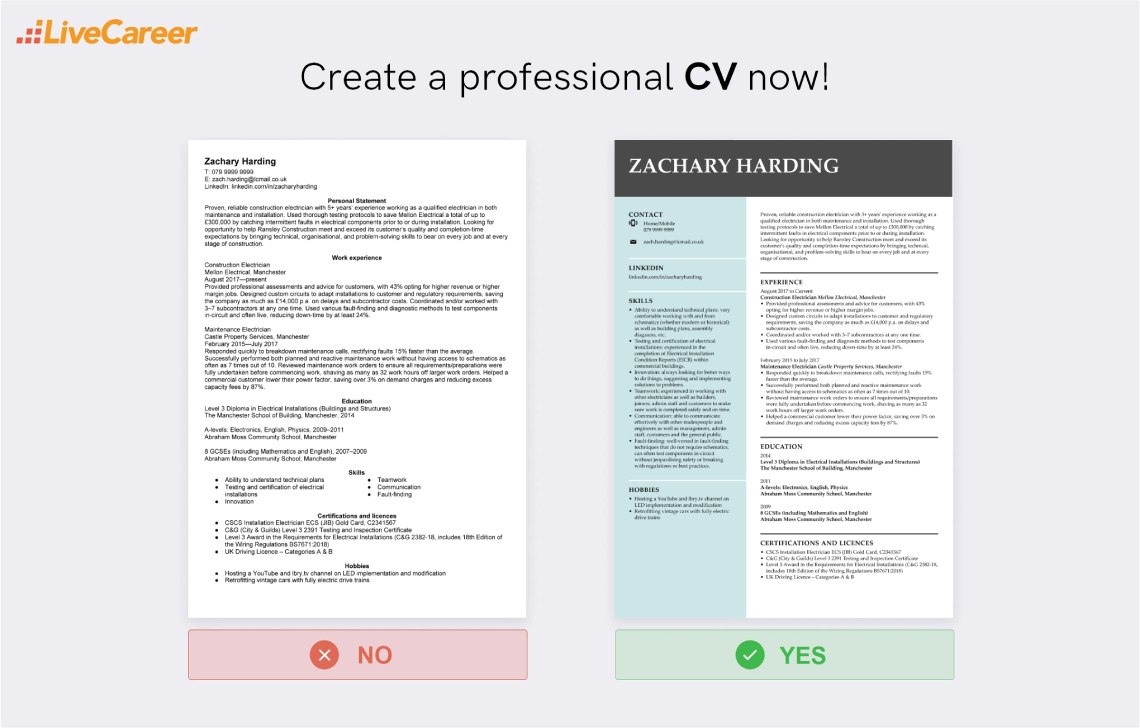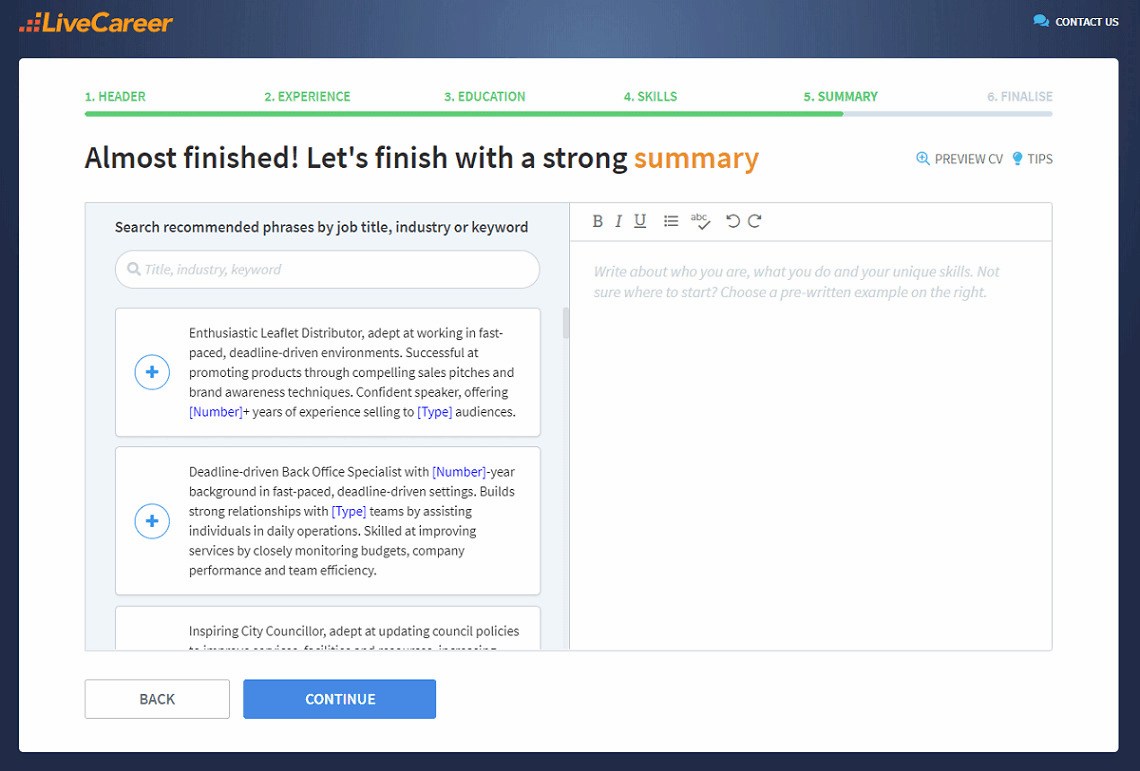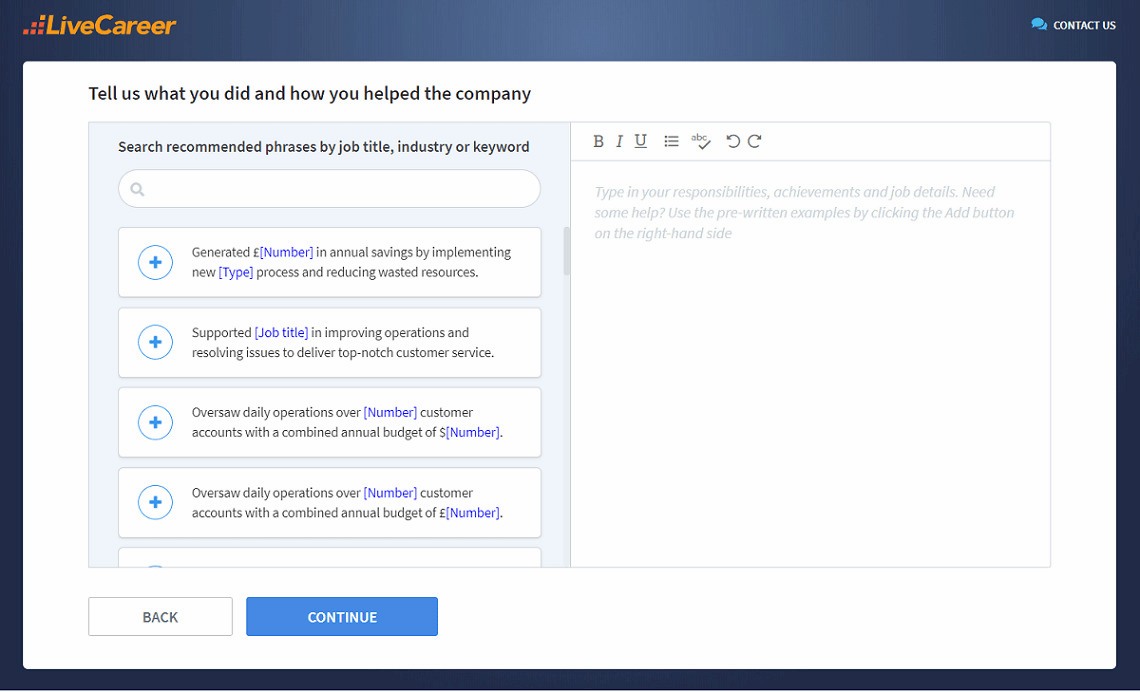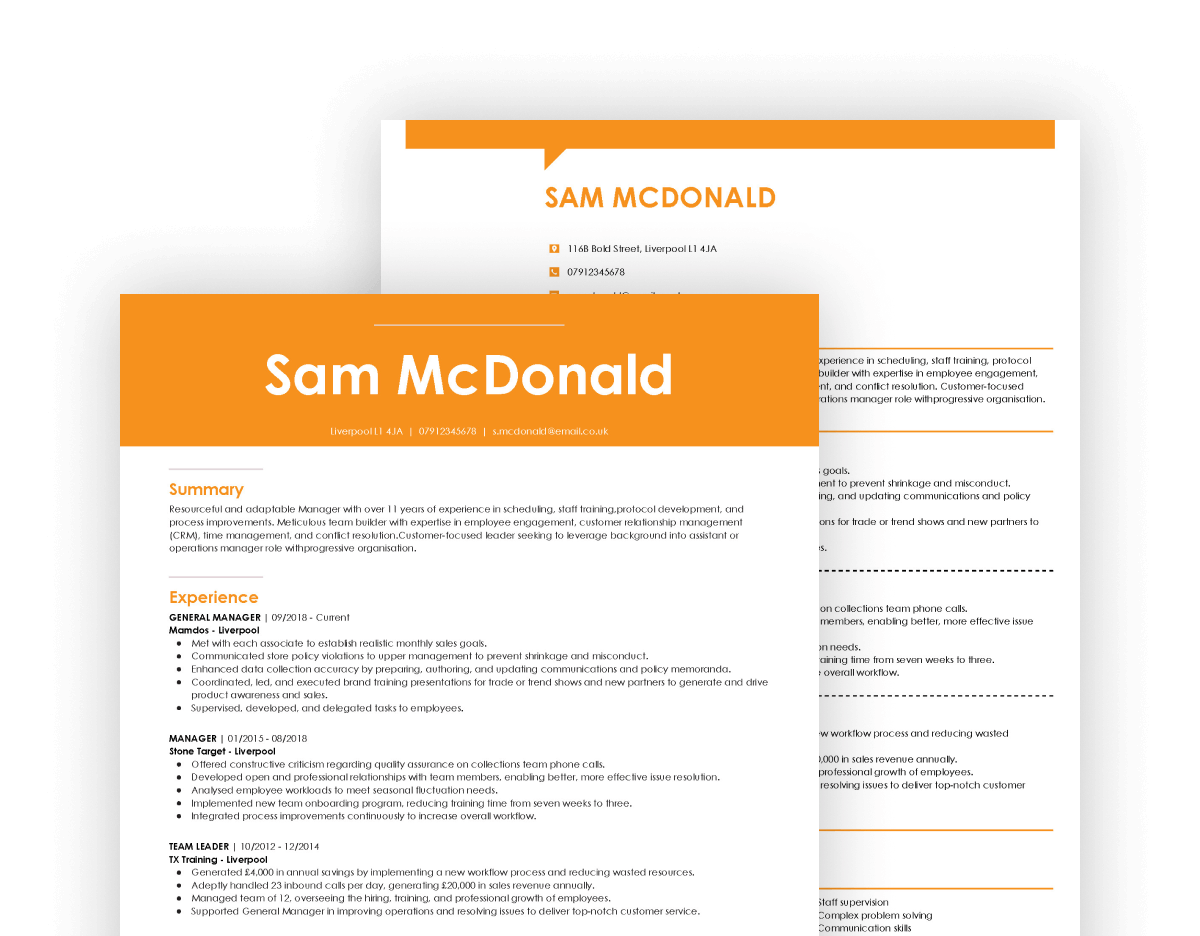Simple / Basic CV Templates + How to Make Them Work
Explore our collection of 15 simple CV templates. These basic CV templates for the UK market use a clean, simple CV format that appeals to recruiters.
Our customers were hired by:
The road to becoming a qualified electrician in the UK can be a long and winding one. A Level 3 and 18th Edition are often just the beginning of what can turn into quite the journey. Depending on what you want to do, you’ll collect ECS cards, C&G awards and certificates galore along the way.
This guide will show you an electrician CV example that is better than most and how to write an electrical CV that will get you the job. You will also learn how to describe your experience on a CV for an electrician like a pro, with epert tips and examples.
Create an effective CV in minutes. Choose a professional CV template and fill in every section of your CV in a flash using ready-made content and expert tips.

We created the sample on the right using our builder. See other good CV examples like this one.
Need a different CV example? Check these samples:
Haven't found what you're looking for? Check all our good CV examples.
Based on over 6 million CVs created in our builder, we found out that*:
*The data comes from a period of the last 12 months (August 2023-August 2024).
Zachary Harding
T: 079 9999 9999
E: zach.harding@lcmail.co.uk
LinkedIn: linkedin.com/in/zacharyharding
Personal Statement
Proven, reliable construction electrician with 5+ years’ experience working as a qualified electrician in both maintenance and installation. Used thorough testing protocols to save Mellon Electrical a total of up to £300,000 by catching intermittent faults in electrical components prior to or during installation. Looking for opportunity to help Ransley Construction meet and exceed its customer’s quality and completion-time expectations by bringing technical, organisational, and problem-solving skills to bear on every job and at every stage of construction.
Work experience
Construction Electrician
Mellon Electrical, Manchester
August 2017—present
Maintenance Electrician
Castle Property Services, Manchester
February 2015—July 2017
Education
Level 3 Diploma in Electrical Installations (Buildings and Structures)
The Manchester School of Building, Manchester, 2014
A-levels: Electronics, English, Physics, 2009–2011
Abraham Moss Community School, Manchester
8 GCSEs (including Mathematics and English), 2007–2009
Abraham Moss Community School, Manchester
Skills
Certifications and licences
Hobbies
So you already know how a good electrician CV looks like. Now, here's how to make a job-winning electrical CV for yourself:
Large potential differences and heart-stopping currents are no joke. You need to trust the people you work with and first impressions are where that trust level is first set. Your personal statement is how you make a first impression in your CV. Make a good one by simply answering these questions:
Answer the above questions in 3–4 sentences (50–150 words) in total and that’s your personal statement sorted. It’s useful to have a formula like this to follow because you’ll be writing a new personal statement for each job application—you’ll tailor your application to each job.
Use the same keywords as those used in the advert wherever possible. This’ll help recruiters see that you tick all their boxes. Your application might also be parsed by an ATS (Applicant Tracking System) before a human being lays eyes on it, so be sure to include the company name and job title as well.
Even though your personal statement comes first in your CV, it’s best that you write it last. You’ll be able to do a much better job once you’ve prepared your job descriptions and written your skills section (it's a CV summary in a way). The above questions about achievements will be a piece of cake by then.
Proven, reliable construction electrician with 5+ years’ experience working as a qualified electrician in both maintenance and installation. Used thorough testing protocols to save Mellon Electrical a total of up to £300,000 by catching intermittent faults in electrical components prior to or during installation. Looking for opportunity to help Ransley Construction meet and exceed its customer’s quality and completion-time expectations by bringing technical, organisational, and problem-solving skills to bear on every job and at every stage of construction.
A strong CV summary will convince the recruiter you’re the perfect candidate. Save time and choose a ready-made personal statement written by career experts and adjust it to your needs in the LiveCareer CV builder.

Just as there are times when a clamp meter is clearly the best way to go, there’s a CV format that’s better suited to a CV for an electrician than any other. Stick to a chronological format, listing your job descriptions from most recent to least. This is what people expect to see and ATSs parse most easily.
Use this template to make a subheading for your current role and each of your previous roles:
[Job Title]
[Company Name, Location]
[Dates of Employment]
Populate each subheading with up to six bullet points. Don’t list duties and responsibilities. Focus instead on achievements: examples of the benefits your actions brought to your employer. Quantify each and every point. Use accomplishment statements to help structure your achievements.
Writing an electrician CV without much experience under your belt? Follow the advice above but focus on any placement work you’ve done or your apprenticeship, if you were lucky enough to have one. If you’re looking to make a start in an electrical trade, then a student CV might be a better fit.
Construction Electrician
Mellon Electrical, Manchester
August 2017—present
Maintenance Electrician
Castle Property Services, Manchester
February 2015—July 2017
A college course certainly isn’t the only way into becoming a qualified electrician, but with the continued scarcity of apprenticeship placements, it remains probably the most common one. In any case, you’ll at least need a Level 3 diploma to work as a fully-fledged electrician.
Put your highest qualifications first by continuing with a reverse-chronological order in your education section. Use this template for any post-secondary education you’ve completed or are completing (include an expected graduation/award date if that’s the case):
[Degree Type] [Degree Name](Degree Class), [Years Attended]
[Institution Name], [Institution Location]
To list your high school education just fill in the templates below:
A-levels: [Subject Name 1], [Subject Name 2], [Subject Name 3]
[School Name], [School Location], [Years Attended]
[n] GCSEs (including Mathematics and English)
[School Name], [School Location], [Years Attended]
where n is the number of GCSEs you completed.
There’s no need to mention high school once you have your Level 3 diploma. The template above assumes that you passed Maths and English GCSEs (something employers often want to see as a minimum)—delete these if they don’t apply to you.
Level 3 Diploma in Electrical Installations (Buildings and Structures)
The Manchester School of Building, Manchester, 2014
A-levels: Electronics, English, Physics, 2009–2011
Abraham Moss Community School, Manchester
8 GCSEs (including Mathematics and English), 2007–2009
Abraham Moss Community School, Manchester
Writing a list of super-impressive electrician skills is easy, that’s why almost everybody looks so legendary on paper. All you need to do is think back to every great electrician you’ve ever worked with and meld all their best qualities into one super-human package. Or you could do something few others do.
Start by opening a new document and brainstorming a list of all of your electrician skills. Aim for a mix of technical and communication skills. It needn’t be an even mix. Now go through and add a sentence to each skill that shows how and when you’ve demonstrated that skill at work. Only demonstrated skills stay.
Save this document—it’ll be the master list of skills that you draw upon when applying for jobs. Go back to the job advert and check what skills are required. Copy 5–10 of your proven skills so that you at least cover those asked for in the advert. Swap out synonyms to match keywords wherever you can.
Your CV is meant to paint a picture of you as an electrician, help it along by including additional sections that paint a fuller portrait. You could include sections that list awards you’ve won, languages you speak, even your hobbies and interests (as long as they’re relevant to the job at hand).
Given the nature of licensing, certification and qualification in the electric and electronic trades, though, you’ll most likely need a whole separate section or two just to cover these, especially if you’re a little more experienced.
These extra CV sections will also vary by specialisation, so a rig electrician CV will look quite different from an auto electrician CV or industrial electrician CV.
Remember that your CV might be scanned by an ATS or picked up by a layperson, so avoid shorthand like ‘18th Edition’ and ‘C&G’. Use ‘the 18th Edition of the Wiring Regulations (BS7671: 2018)’ and make it clear when equivalents are in play (e.g. a ECS/JIB card).
Also, think outside the box: you could mention your liability insurance, Asbestos Awareness Certificate or even DBS Certificate. The idea is not to pad your CV but to hand-pick certifications and licences that are relevant to the role in question.
Certifications and licences
Hobbies
Sending in an electrician CV without a cover letter is leaving the job half done. And like half a circuit, half a job application can’t be expected to do much. It’s true that some employers don’t pay much attention to cover letters, but you should always include one unless explicitly asked not to.
Follow a standard UK business letter format, which means including:
This is called the standard letter format for a reason—all well-written cover letters will follow it. You can stand out from the crowd through the way in which you approach the body of your cover letter. Your body paragraphs should include:
Your electrician cover letter should end up being between half and one A4 page, about 250–400 words in total, including:
So now you’ve got the contents of your electrician CV ready. But before you send it to the recruiter or the hiring manager, take these last few tips to heart.
Many if not most electrical trade job adverts will mention the need for references, usually three. Should you include references on a CV? The short answer is a resounding ‘no’. Attach them as a separate document and put off locking them in until later in the recruitment process if at all possible.
Even quick, sketched-out schematics follow certain CV layout rules. Keep in mind the following when putting the final touches on your electrician CV:
You wouldn’t expect much from a workmate who mixed up his lowercase and uppercase m’s. It’s not like anyone’s going to be in any doubt of whether he means 20mW or 20MW but that’s not the point. It speaks to a general sloppiness that you just don’t want in an electrician. Don’t be that person.
Go through your electrician CV and cover letter with a fine-tooth comb looking for spelling and grammar mistakes. Use an app, web app, or built-in spellchecker. Get someone to read through your documents—there’s nothing like a second pair of eyes.
Call or email to follow up if you haven’t heard back after a week. This’ll make a good impression with the recruiter and might let you know how your application is fairing.
You don’t have to be a CV writing expert. In the LiveCareer CV builder you’ll find ready-made content for every industry and position, which you can then add with a single click.

I hope this article has put you on the right track when it comes to writing your electrician CV. Is there anything that you’d like more information on? Do you like our construction electrician CV sample? Do you have anything to add? Leave your questions, comments and feedback in the comments section below!
Our editorial team has reviewed this article for compliance with Livecareer’s editorial guidelines. It’s to ensure that our expert advice and recommendations are consistent across all our career guides and align with current CV and cover letter writing standards and trends. We’re trusted by over 10 million job seekers, supporting them on their way to finding their dream job. Each article is preceded by research and scrutiny to ensure our content responds to current market trends and demand.
About the author
Since 2013, the LiveCareer UK team has shared the best advice to help you advance your career. Experts from our UK editorial team have written more than one hundred guides on how to write the perfect CV or cover letter.
Rate this article:
Electrician cv
Average:

Explore our collection of 15 simple CV templates. These basic CV templates for the UK market use a clean, simple CV format that appeals to recruiters.
Wondering whether to put your address on a CV? Explore when to skip your CV address and when to perfect your CV address presentation for success.
Is it illegal to lie on your CV? Can you hand in a fake CV? Lying on a CV is a terrible idea either way. There's no such thing as white lies on a CV. See why.
Our customers were hired by: